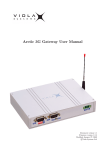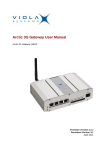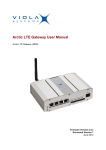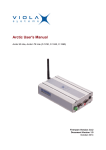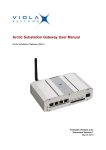Download Viola M2M Gateway User Manual
Transcript
Viola M2M Gateway User Manual Document version 3.0 Modified June 25, 2008 Firmware version 2.4 Contents 1 Introduction 1.1 About Viola M2M Gateway 1.2 M2M Gateway Features . . 1.3 Packaging information . . . 1.4 Hardware description . . . . 1.4.1 Front panel . . . . . 1.4.2 Back panel . . . . . 1.4.3 Product Label . . . . . . . . . . . . . . . . . 6 6 6 7 7 7 8 8 . . . . . . . . . . . . . . . . . . . . . . . . . . . . . . . . . . . . . . . . . . . . . . . . . . . . . . . . . . . . . . . . . . . . . . . . . . . . . . . . . . . . . . . . . . . . . . . . . . . . . . . . . . . . . . . . . . . . . . . . . . . . . . . . . . . . . . . . . . . . . . . . . . . . . . . . . . . . . . . . . . . . . . . . . . . . . . . . . . . . . . . . . . . . . . . . . . . . . . . . . . . . . . . . . . . . . . . . . . . . . . . . . . . . . . . . . . . . . . . . . . . . . . . . . . . . . . . . . . . 2 Network Requirements 2.1 Connection Principle . . . . . . . 2.2 Minimal Network Requirements . 2.3 Routing Setup . . . . . . . . . . 2.4 Other Network Services . . . . . 2.5 Recommended Network Setup . . 2.6 Using the Second Ethernet Port . . . . . . . . . . . . . . . . . . . . . . . . . . . . . . . . . . . . . . . . . . . . . . . . . . . . . . . . . . . . . . . . . . . . . . . . . . . . . . . . . . . . . . . . . . . . . . . . . . . . . . . . . . . . . . . . . . . . . . . . . . . . . . . . . . . . . . . . . . . . . . . . . . . . . . . . . . . . . . . . . . . . . . . . . . . . . . . . . . . . . . . . . . . . . . . . . . . . . . . . . . . . . . . . . . . 9 . 9 . 9 . 9 . 10 . 10 . 10 3 Quick Installation 11 3.1 Setting IP Address Using Web Browser . . . . . . . . . . . . . . . . . . . . . . . . . . . . . . . . 11 4 Network Configuration 13 4.1 Configuration screens . . . . . . . . . . . . . . . . . . . . . . . . . . . . . . . . . . . . . . . . . . . 13 5 VPN connectivity 5.1 VPN requirements . . . . . . . 5.2 Available VPN types . . . . . . 5.3 Typical connection scheme . . . 5.4 Typical connection scheme with . . . . . . . . . . . . . . . routing . . . . . . . . . . . . . . . . . . . . . . . . . . . . . . . . . . . . . . . . . . . . . . . . . . . . . . . . . . . . . . . . . . . . . . . . . . . . . . . . . . . . . . . . . . . . . . . . . . . . . . . . . . . . . . . . . . . . . . . . . . . . 14 . 14 . 14 . 14 . 15 6 SSH-VPN Configuration 6.1 Introduction to SSH-VPN . . . 6.2 SSH-VPN configuration screen 6.3 Creating new connection . . . . 6.4 Checking connection . . . . . . 6.5 Finalising SSH-VPN setup . . . 6.6 Editing existing connection . . 6.7 SSH port configuration . . . . . . . . . . . . . . . . . . . . . . . . . . . . . . . . . . . . . . . . . . . . . . . . . . . . . . . . . . . . . . . . . . . . . . . . . . . . . . . . . . . . . . . . . . . . . . . . . . . . . . . . . . . . . . . . . . . . . . . . . . . . . . . . . . . . . . . . . . . . . . . . . . . . . . . . . . . . . . . . . . . . . . . . . . . . . . . . . . . . . . . . . . . . . . . . . . . . . . . . . . . . . . . . . . . . . . . . . . . . . . . . . . . . . . . . . . . . . . . . . . . . . . . . . . . . . . . . . . . . . . . . 16 16 16 17 18 19 19 19 7 L2TP-VPN Configuration 20 7.1 Introduction to L2TP-VPN . . . . . . . . . . . . . . . . . . . . . . . . . . . . . . . . . . . . . . . 20 7.2 L2TP-VPN configuration screen . . . . . . . . . . . . . . . . . . . . . . . . . . . . . . . . . . . . 20 7.3 Creating new connection . . . . . . . . . . . . . . . . . . . . . . . . . . . . . . . . . . . . . . . . . 21 8 OpenVPN Configuration 9 Additional System Configuration 9.1 Changing system password . . . . . 9.2 Firewall . . . . . . . . . . . . . . . . 9.2.1 Firewall configuration screen 9.2.2 Changing firewall rules . . . . 22 . . . . . . . . . . . . . . . . . . . . . . . . 1 . . . . . . . . . . . . . . . . . . . . . . . . . . . . . . . . . . . . . . . . . . . . . . . . . . . . . . . . . . . . . . . . . . . . . . . . . . . . . . . . . . . . . . . . . . . . . . . . . . . . . . . . . . . . 23 . 23 . 23 . 24 . 24 CONTENTS 9.3 9.4 9.5 9.6 9.7 2 Date and time . . . . . . . . . . . . . . . 9.3.1 Manual configuration . . . . . . . 9.3.2 Automatic configuration with NTP Backup . . . . . . . . . . . . . . . . . . . 9.4.1 Backup screen . . . . . . . . . . . 9.4.2 Creating backups . . . . . . . . . . 9.4.3 Restoring backups . . . . . . . . . 9.4.4 Moving backups between units . . System logs . . . . . . . . . . . . . . . . . Supportlog . . . . . . . . . . . . . . . . . Factory default settings . . . . . . . . . . . . . . . . . . . . . . . . . . . . . . . . . . . . . . . . . . . . . . . . . . . . . . . . . . . . . . . . . . . . . . . . . . . . . . . . . . . . . . . . . . . . . . . . . . . . . . . . . . . . . . . . . . . . . . . . . . . . . . . . . . . . . . . . . . . . . . . . . . . . . . . . . . . . . . . . . . . . . . . . . . . . . . . . . . . . . . . . . . . . . . . . . . . . . . . . . . . . . . . . . . . . . . . . . . . . . . . . . . . . . . . . . . . . . . . . . . . . . . . . . . . . . . . . . . . . . . . . . . . . . . . . . . . . . . . . . . . . . . . . . . . . . . . . . . . . . . . . . . . . . . . . . . . . . . . . . . . . . . . . . . . . . . . . . . . . . . . . . . . . . . . 24 25 25 25 25 26 26 26 26 27 27 10 Advanced settings 28 11 Troubleshooting 30 12 Technical Specifications 31 13 Limited Warranty 13.1 Coverage . . . . . . . . . . . . . 13.2 Excluded Products and Problems 13.3 Remedies . . . . . . . . . . . . . 13.4 Obtaining Warranty Service . . . . . . . . . . . . . . . . . . . . . . . . . . . . . . . . . . . . . . . . . . . . . . . . . . . . . . . . . . . . . . . . . . . . . . . . . . . . . . . . . . . . . . . . . . . . . . . . . . . . . . . . . . . . . . . . . . . . . . . . . . . . . . . . . . . . . . . . . . . . . . . 32 . 32 . 32 . 32 . 32 14 Technical Support 33 14.1 Contacting Technical Support . . . . . . . . . . . . . . . . . . . . . . . . . . . . . . . . . . . . . . 33 14.2 Recording Product Information . . . . . . . . . . . . . . . . . . . . . . . . . . . . . . . . . . . . . 33 Copyright and Trademark Copyright © 2008, Viola Systems Ltd. All rights to this manual are owned solely by Viola Systems Ltd. (referred in this manual as Viola Systems). All rights reserved. No part of the contents of this manual may be transmitted or reproduced in any form or by any means without the written permission of Viola Systems. Ethernet is a trademark of XEROX Corporation. Windows and Internet Explorer are trademarks of Microsoft Corporation. Netscape is a trademark of Netscape Communications Corporation. Linux is a Registered Trademark of Linus Torvalds. All other product names used in this manual are the properties of their respective owners and are acknowledged. Contact Information . Viola Systems Ltd. Lemmink¨ aisenkatu 14 - 18 B FIN-20520 Turku Finland Technical Support Phone: +358 (0)20 1226 226 Fax: +358 (0)20 1226 220 E-mail: [email protected] On-line: http://www.violasystems.com/ 3 Disclaimer and Revisions Viola Systems reserves the right to change the technical specifications or functions of its products, or to discontinue the manufacture of any of its products or to discontinue the support of any of its products, without any written announcement and urges its customers to ensure, that the information at their disposal is valid. Viola software and programs are delivered “as is”. The manufacturer does not grant any kind of warranty including guarantees on suitability and applicability to a certain application. Under no circumstances is the manufacturer or the developer of a program responsible for any possible damages caused by the use of a program. The names of the programs as well as all copyrights relating to the programs are sole property of Viola Systems. Any transfer, licensing to a third party, leasing, renting, transportation, copying, editing, translating, modifying into another programming language or reverse engineering for any intent is forbidden without the written consent of Viola Systems. Viola Systems has attempted to verify all information in this manual as of the publication date. We assume no responsibility for any errors that may appear in this guide. Information in this manual may change without prior notice from Viola Systems. Revision History 05/2004 Manual released, version 1.0 08/2004 Version 2.0 06/2008 Version 3.0 4 Warranty and Safety Instructions Read these safety instructions carefully before using the product: Warranty will be void, if the product is used in any way, which is in contradiction with the instructions given in this manual, or if the product has been tampered with. The devices mentioned in this manual are to be used only according to the instructions described in this manual. Faultless and safe operation of the devices can be guaranteed only if the transport, storage, operation and handling of the devices is appropriate. This also applies to the maintenance of the products. To prevent damage both the product and any terminal devices must always be switched OFF before connecting or disconnecting any cables. It should be ascertained that different devices used have the same ground potential. Before connecting any power cables the output voltage of the power supply should be checked. This product is not fault-tolerant and is not designed, manufactured or intended for use or resale as online control equipment in hazardous environments requiring fail-safe performance, such as in the operation of nuclear facilities, aircraft navigation or communication systems, air traffic control, direct life support machines, or weapons systems, in which the failure of our hardware or software could lead directly to death, personal injury, or severe physical or environmental damage. 5 Chapter 1 Introduction This document describes how to configure the Viola M2M Gateway product. 1.1 About Viola M2M Gateway The Viola M2M Gateway is a network device that enables VPN connection between company network and remote Arctic devices. It can also be used to control and monitor Arctic devices in local or remote networks. Concept of the Viola M2M Gateway is described in figure 1.1. Figure 1.1: Viola M2M Gateway concept Only a computer with network connection and a HTML browser is required to configure the M2M Gateway. Using the M2M Gateway Web user interface you can configure and view the status of the remote Arctic devices and configure the VPN connection between M2M Gateway and Arctic device. Arctics have a WWW user interface which can be used to configure them using a HTML browser. For the rest of this documentation, the Viola M2M Gateway is referred as M2M Gateway. 1.2 M2M Gateway Features The M2M Gateway offers different advanced features for network usage. In most simple usage only VPN feature is used, but M2M Gateway makes possible to make complex network configurations. Routing M2M Gateway can forward packets to local Ethernet (eth0) which it is connected to company network. Also it is possible to route packets to second Ethernet (eth1) of M2M Gateway. More complex routing solutions can be made but they need consultation of your local network administrator. 6 CHAPTER 1. INTRODUCTION 7 Firewall The M2M Gateway has internal firewall with graphical user interface. It is possible to connect M2M Gateway directly to the Internet and filter unwanted connections without external firewall. The recommend method is to use a dedicated firewall and install M2M Gateway behind it. VPN VPN is used to connect remote Arctic devices to local network. Connection is started by Arctic and the M2M Gateway decides based on its configuration does it allow remote Arctic start VPN connection. VPN connection can be disabled from M2M Gateway. If connection is for some reason terminated, it comes automatically back up. Remote Management M2M Gateway offers full remote management. Also traditional console access is available using SSH. 1.3 Packaging information The product package should contain the following items: Viola M2M Gateway Power cord Viola M2M Gateway Quick Start Guide 1.4 Hardware description This section describes the front and back panel features of M2M Gateway. 1.4.1 Front panel M2M Gateway front panel is shown in figure 1.2. Figure 1.2: Front panel LEDs and switches (from left to right): 1. Temp LED, lit if system temperature is too high 2. Nic 2 activity LED (Eth 1 / LAN) 3. Nic 1 activity LED (Eth 0 / WAN) 4. HD activity LED 5. Power LED 6. Reset switch 7. Power switch CHAPTER 1. INTRODUCTION 1.4.2 8 Back panel M2M Gateway back panel is shown in figure 1.3. Figure 1.3: Back panel Connectors (from left to right): 1. Power plug 2. Mouse and keyboard connector 3. USB connectors 4. Serial connector 5. Parallel connector 6. VGA display connector 7. Ethernet 0 connector (Eth0 / WAN) 8. Ethernet 1 connector (Eth1 / LAN) 1.4.3 Product Label Product label is found on the bottom of the device and it contains the basic information about the unit such as product name, serial number and MAC addresses of Ethernet ports. Figure 1.4: Product label Chapter 2 Network Requirements To work properly M2M Gateway requires the parameters described in this chapter to be configured. For your network settings contact your local network administrator. Note: Misconfiguration of the M2M Gateway can seriously hinder your network. Make sure you verify your network configuration with local network administrator. 2.1 Connection Principle Company Intranet is normally connected to Internet via firewall. Figure 2.1shows the M2M Gateway connected to the Demilitarized Zone (DMZ) of the firewall. This configuration allows hosts from Company Intranet to connect via firewall to the M2M Gateway. Other configurations are also possible. Figure 2.1: DMZ Connection Note: It is possible that internal routing in company intranet may require configuration in order to integrate M2M Gateway to an existing network. 2.2 Minimal Network Requirements At it’s minimum the M2M Gateway requires these settings One public IP address for M2M Gateway SSH port (default 22) unblocked for incoming connections to M2M Gateway from the remote network Although this configuration is minimal it can be used for testing and evaluating more complex systems. It is always recommended to consult local network administrator when installing new servers to public network. 2.3 Routing Setup When the M2M Gateway is installed to existing network some configuration require adding route to M2M Gateway and devices behind it. This means that for example local firewall to router needs to be aware of routes going via the M2M Gateway. Routing can be complex to setup in large networks and it is recommend to consult local network administrator also about routing. 9 CHAPTER 2. NETWORK REQUIREMENTS 2.4 10 Other Network Services M2M Gateway network services are listed in table 2.1. The only mandatory service is Secure Shell (SSH). SSH server listens for incoming connections from Arctic devices in port 22 (default). This port must not be blocked by any firewall otherwise the remote Arctic devices are not able to open VPN connections to the M2M Gateway. Arctic uses ICMP ECHO (ping) messages to check it’s network connection to the M2M Gateway. By default the private IP address of the VPN peer is used as the target for the network connection status check. I.e. the M2M Gateway is not required to accept ICMP ECHO messages. The network connection status check can also be made using some public IP address (e.g. the public IP address of the M2M Gateway). In this case the target host of the network connection check is required to accept ICMP ECHO messages and that they are not blocked by any firewall. Service SSH ICMP ECHO OpenVPN L2TP Default Port 22 1194 1701 Protocol TCP ICMP TCP / UDP UDP Description SSH-VPN tunnel, SSH remote access Network connection checking OpenVPN tunnel L2TP-VPN tunnel Table 2.1: Network services 2.5 Recommended Network Setup The M2M Gateway is recommended to be connected to a DMZ of a firewall. This way the M2M Gateway can have public or private IP address depending on the firewall configuration. When placed in DMZ the firewall protects efficiently against any unauthorized access to the M2M Gateway. Only incoming SSH connections are required to have access to DMZ zone. Services other than SSH are optional. If the M2M Gateway is located in the DMZ and it has a private IP address the firewall has to support port forwarding or destination network address translation (DNAT). For firewall configuration please refer to your firewall documentation or to your local network administrator. Figure 2.2: Recommended network setup 2.6 Using the Second Ethernet Port If a firewall or network configuration does not allow the use of a DMZ or only few host has to have access to the M2M Gateway, the second Ethernet can be used. The second Ethernet of the M2M Gateway can be enabled from the Web user interface. The IP address of the second Ethernet of the M2M Gateway is then used as the default gateway for the devices connected to the second Ethernet port. Figure 2.3: Second Ethernet port in use Chapter 3 Quick Installation This chapter describes how to configure the network interfaces on M2M Gateway. 3.1 Setting IP Address Using Web Browser This section describes how to change factory default IP address for the first time. 1. Connect the cross-over Ethernet cable between Viola M2M Gateway (Ethernet 0 connector) and your configuration computer. 2. Configure your computer to use the same IP address space than Viola M2M Gateway (laptop IP for example 10.10.10.11 with netmask 255.0.0.0). Check with ping command. 3. Connect to the Viola M2M Gateway using your web browser. The default IP address of Viola M2M Gateway is 10.10.10.10 (netmask 255.0.0.0). Note that you have to connect to a HTTPS port 10000 (see figure 3.1). Figure 3.1: Browser https example 4. Your browser might mention about certificates, you can safely ignore them at this point. 5. When you get to the login screen enter username and password and press Login button. Figure 3.2: Login screen Note: Default username is viola-adm and default password is violam2m. It is recommended that the default password is changed before the product is connected to a public network. 11 CHAPTER 3. QUICK INSTALLATION 12 6. Now you should be logged in a see a main configuration menu. Icons on the blue background are primary navigation icons and they are always visible on the screen. Icons lower are secondary navigation icons and clicking them allows the user to change the specific settings they represent. See figure 3.3. Figure 3.3: Main configuration menu 7. Select Network Configuration icon on the first page. 8. From the next screen select Network Interfaces icon. 9. Below the text “Interfaces Activated at Boot Time” select eth0. Figure 3.4: Select eth0 interface 10. Enter your preferred configuration to the configuration fields. Figure 3.5: Ethernet configuration 11. Press Save and Apply button when you are ready to activate your new settings. Note that your existing web browser connection hangs up after you apply the settings, so open a new connection to the new IP address (check your Ethernet cabling) 12. Now you should be able to connect to the M2M Gateway with your new IP address. Chapter 4 Network Configuration This chapter describes how to configure network interfaces on M2M Gateway. 4.1 Configuration screens Network configuration screens can be found from main menu and pressing Network Configuration icon. Figure 4.1: Network configuration menu Network Interfaces Displays running network configuration on the top on Interfaces Active Now list. This list contains all the interfaces running locally, including VPN interfaces. On the bottom there is a listing of physical interfaces (eth0 and eth1). Interface confiuration can be changed by pressing underlined interface name. See figure 4.2. Figure 4.2: Network interface list Routing and Gateways Configures default route, static routes and displays running routes. Default route can be changed from this screen. Enter correct interface and IP address and press Save button. Note: do not define more than one default route. Hostname and DNS Client Configures hostname and DNS settings. Host Addresses Shows hostnames assigned to IP addresses. 13 Chapter 5 VPN connectivity 5.1 VPN requirements VPN implementation on M2M Gateway requires Open port in firewall for selected VPN server port Fixed IP address for M2M Gateway accessible from public Internet or used APN Remote client to connect to M2M Gateway (most commonly Viola Arctic product) Usually third node to monitor the connections and to access remote nodes (laptop, central management) Note that the M2M Gateway needs a fixed IP address. 5.2 Available VPN types Available types are L2TP, SSH and OpenVPN, small comparison is shown in table 5.1. SSH-VPN L2TP-VPN OpenVPN Description Default tunnel for Viola Arctic products Lighter but less secure alternative to SSH-VPN Best option for laptops and remote management Encryption yes no yes Default port 22 TCP 1701 UDP 1194 UDP Table 5.1: VPN comparison table Selection of VPN depends on requirements, available link capacity and used hardware. 5.3 Typical connection scheme Typical connection scheme is described in figure 5.1: Figure 5.1: Typical VPN connection 14 CHAPTER 5. VPN CONNECTIVITY 15 Network configuration in VPN tunneling will be easier if some rules are followed: Network addresses can not overlap, it is always best to use dedicated IP address range for VPN tunnels. Remember that VPN tunnel addresses are only visible between M2M Gateway and remote node. Netmasks should be strict to prevent network overlapping. Draw a network diagram with all the relevant information about the network you are building. 5.4 Typical connection scheme with routing This example shows a little larger system. This common setup is practical in connecting remote networks to as a part of local network. This could be used to connect isolated remote stations to local monitor station. Figure 5.2: Typical network setup with routing As the previous example explained some of the basic operations, this example assumes that those are clear at the time of reading this. If this is not the case, please take some time and browse the user interfaces of both M2M Gateway and Arctic. This will make the settings more familiar to you. Select routing mode to Tunnel the following network. IP address and netmask is the address that is located in the opposite side of the tunnel. For example, on Arctic set IP address to be the address that is assigned to the eth1 of M2M Gateway and vice versa. Chapter 6 SSH-VPN Configuration This chapter describes how to use SSH-VPN module on Viola M2M Gateway. 6.1 Introduction to SSH-VPN SSH-VPN uses SSH keys and remote nodes hostname to authenticate and validate remote connections. It is the default VPN for Viola Arctic products. 6.2 SSH-VPN configuration screen Figure 6.1: SSH-VPN configuration screen Configuration screen can be divided into different regions: On the top are summary about peers and their last check. Configured connections are listed next. If the number of peers is over 500, list is divided to multiple pages. Below the list are connection test buttons. Key management field is located below peer list. Here are listed only those peers that do not have a key yet. If existing key for a peer needs to be changed, it must be done by editing the peer. 16 CHAPTER 6. SSH-VPN CONFIGURATION 17 On a bottom is SSH port configuration field. Using action buttons on the peer list, the connections can be managed and monitored easily. See figure 6.2. Figure 6.2: SSH-VPN peer listing Possible actions are visible in (link to figure), these are (from left to right): 1. Connectivity test selection box 2. Peer status icon (enabled or disabled) 3. Key status icon 4. Peer name 5. Interface assigned to peer 6. IP pair assigned to tunnel 7. Routing mode (none or network) 8. Remote IP if routing mode is set to network 9. Netmask if routing mode is set to network 10. Status (Active or Inactive) 11. Check status from last check (n/a, OK or Failed) 12. Enable/Disable button 13. Edit button 14. Remove button 6.3 Creating new connection To configure a new connection 1. Go to SSH-VPN configuration page 2. Press Add peer button (located between peer list and key management box). See figure 6.1. 3. Enter values to fields. Required fields are peer name and IP pair. See figure 6.3. Note: Peer name must be same than hostname on Arctic 4. Press Confirm button and return to previous screen Figure 6.3: SSH-VPN peer creation screen After a new peer has been created, it will show up in peer list and its status will be disabled. To enable it, the keys must be exchanged between Viola M2M Gateway and Arctic. To do this CHAPTER 6. SSH-VPN CONFIGURATION 18 1. Open Arctic user interface and SSH-VPN configuration screen on M2M Gateway to separate web browser windows 2. On the Arctic, navigate to Network->SSH-VPN page 3. Copy key from Arctic to M2M (see figure 6.4) 4. Select correct peer from list on M2M, paste Arctic key below and press Enter key button 5. Copy M2M key from Server public key field 6. Copy key from M2M to Arctic (see figure 6.4) Figure 6.4: SSH-VPN key exchange After the keys are exchanged, the peer can be enabled on the M2M Gateway. Just press Enable button on the peer list. Please note that the Arctic needs to be restarted before the connection comes up. After the Arctic restarts and connects, the peer status can be checked on the M2M by selecting a checkbox on the peer list and pressing Start check button. For more information about configuring Arctic, refer to Arctic User Manual. 6.4 Checking connection Connection status displayed on SSH-VPN page does not update automatically, it has to be updated manually is current status needs to be checked. To check current status of a peer: 1. Checked peers are selected by using checkboxes next to peer names. Peers can be selected individually or they can all be selected using Check all button. 2. Connection check is started by pressing Start check button. After the check is done, the results are displayed above the peer list (Checked n Peers -> n OK | n Failed date). 3. Results for individual peers can be seen on Check column on peer list. Note: peer interface tells which interface is assigned to a peer. It is a local interface on M2M Gateway and it can not be used to determine the current connection status. CHAPTER 6. SSH-VPN CONFIGURATION 6.5 19 Finalising SSH-VPN setup After all the peers have been configured there are couple issues that need some attention. 1. Keys needs to be locked. This can be done by pressing Lock keys button. This locks the keys and prevents their accidental deletion. 2. Create backup. Instructions for this can be found in section 9.4. 6.6 Editing existing connection Peers can be edited by selecting Edit button from the peer list. All the parameters except peer name can be changed from this edit screen. Note that the keys must be unlocked if keys need to be changed. Figure 6.5: SSH-VPN peer edit screen 6.7 SSH port configuration Default port for SSH is 22. It is recommended to change this to something less common to increase system security. Changing SSH port on M2M Gateway is done by entering new port to a configuration field located in the bottom of the SSH-VPN configuration screen and pressing Change port button. Note that changing SSH port on M2M Gateway requires configuration changes to SSH-VPN connected Arctics as well. Also remote SSH access has to use new port. Chapter 7 L2TP-VPN Configuration 7.1 Introduction to L2TP-VPN L2TP-VPN uses username and password to authenticate and validate remote connections. It is available on Viola Arctic products. 7.2 L2TP-VPN configuration screen Configuration screen is shown in figure 7.1. Figure 7.1: L2TP-VPN configuration screen Using action buttons on the peer list, the connections can be managed and monitored easily. See figure 7.2. Possible actions are visible in (link to figure), these are (from left to right): 1. Connectivity test selection box 2. Peer status icon (enabled or disabled) 3. Peer name 4. Interface, available if peer is up 20 CHAPTER 7. L2TP-VPN CONFIGURATION 21 5. IP pair assigned to tunnel 6. Routing mode (none or network) 7. Remote IP if routing mode is set to network 8. Netmask if routing mode is set to network 9. L2TP username 10. L2TP password 11. Status (Active or Inactive) 12. Check status from last check (n/a, OK or Failed) 13. Enable/Disable button 14. Edit button 15. Remove button Figure 7.2: L2TP-VPN peer listing 7.3 Creating new connection To create new connection: 1. From the L2TP-VPN configuration screen select Add peer button. 2. Fill in the settings for the tunnel. For simple point-to-point tunnel only peer name and IP pair are needed. Peer name is the hostname of the Viola Arctic that forms the other end of the tunnel. IP pair is an IP pair that does not conflict with any other address used. See figure 7.3. 3. Routing mode selects if the network on the other side of the tunnel is routed thorough the tunnel. Remote network IP and network mask define the remote network routed thorough the tunnel. 4. Username and password must be the same than on the Viola Arctic. 5. When you are done, press Confirm button to save the settings. The tunnel should now be added to the tunnel list. 6. Enable the tunnel by clicking Enable text. 7. The connection can be tested by selecting the checkbox next to the peer name and pressing the Start check button. See figure 7.1. Figure 7.3: L2TP-VPN new peer Chapter 8 OpenVPN Configuration Please refer to Viola Systems’ OpenVPN application note. 22 Chapter 9 Additional System Configuration 9.1 Changing system password It is always recommended that the default password will be changed during the installation. To change the password for user interface login: 1. From the top icon row on the blue background, select System icon. 2. From the System page select Change Passwords icon. 3. From the user list select user viola-adm. 4. Enter new system password and press Change to commit the new password. See figure 9.1. Figure 9.1: Password change screen Note that the only users who can log in a system are viola-adm and root. User viola-adm is the only one who can log in to a web user interface. User root can log in only locally, remote root access is restricted. 9.2 Firewall Firewall in an important part of the M2M Gateway product. Firewall should always be turned on and configured as strict as possible to keep out any unauthorized traffic. It is not recommended to use M2M Gateway without firewall turned on if connected to any public network. For more detailed explanation about firewall configuration, refer to application note Configuring Viola M2M Gateway firewall. 23 CHAPTER 9. ADDITIONAL SYSTEM CONFIGURATION 9.2.1 Firewall configuration screen To reach the firewall configuration screen: 1. Login to M2M Gateway and enter the web user interface main menu 2. From the top icon row on the blue background, select Networking icon 3. From the Networking page select Linux Firewall icon The firewall configuration is divided into sections: Firewall has three chains (input, forward and output) which are listed separately. Figure 9.2: Firewall chain listing On the bottom there are action buttons which can be used to apply or revert the changes. Figure 9.3: Firewall action buttons 9.2.2 Changing firewall rules Default firewall rules allow only Arctic traffic. Rules can be changed in firewall configuration screen: 1. Existing firewall rules can be modified by clicking the Action text (colored Drop/Accept) 2. Adding new rules can be done by clicking the blue arrows on the left side of the rules 3. Modified rules can be applied or old rules can be reseted using the buttons at the end of the page The modified rules have to be applied by pressing Apply Configuration button before they are in use. 9.3 Date and time It is important to have date and time set up correctly if certificate-based VPNs are in use. To configure date and time: 1. Login to M2M Gateway and enter the web user interface main menu 2. From the top icon row on the blue background, select System icon 3. From the System page select System Time icon There are two methods to configure system time, manual and automatic with NTP protocol. 24 CHAPTER 9. ADDITIONAL SYSTEM CONFIGURATION 9.3.1 25 Manual configuration To configure system time manually: Enter time and date to system time and press Apply, then Set system time to hardware time. Figure 9.4: Manual system time configuration 9.3.2 Automatic configuration with NTP To configure system time automatically with NTP protocol: Enter valid ntp server address to timeserver field and press Sync and Apply button on the bottom of the screen. Figure 9.5: Automatic system time configuration 9.4 Backup The Backup module saves user made settings of the Viola M2M Gateway. It backups configuration files and keys of VPN tunnels and firewall settings. 9.4.1 Backup screen Backup screen can be found from the Web user interface main screen. Press Viola M2M Backup icon to open backup screen. CHAPTER 9. ADDITIONAL SYSTEM CONFIGURATION 26 Figure 9.6: Backup screen 9.4.2 Creating backups From the first page select Viola M2M Backup icon and press create backup button to create a backup file. When the backup is created succesfully, a notification text appears. Figure 9.7: Backup created message 9.4.3 Restoring backups Press open button to select the backup you want to restore and press restore backup button to restore the backup. Figure 9.8: Backup restore selection 9.4.4 Moving backups between units To restore a backup on a different machine, the backup file has to be copied into the /opt/viola/m2mBackups/ directory on the second machine. Besides that the MD5 file has also to be copied onto the new machine. This file has to copied into the /opt/viola/MD5/ directory. After restoring the backup as described above, the IP address has to be changed to the IP address of the machine the backup was created on. Afterwards the secondary unit can replace the primary unit seamlessly without any further configuration. 9.5 System logs To reach the system logs: 1. Login to M2M Gateway and enter the web user interface main menu 2. From the top icon row on the blue background, select System icon 3. From the System page select System Logs icon Logs can be searched with defined text or just show last n entries. CHAPTER 9. ADDITIONAL SYSTEM CONFIGURATION 27 Figure 9.9: System log view OpenVPN has its own logs which can be found from OpenVPN configuration. 9.6 Supportlog Supportlog is a module that helps Viola Systems’ technical support team in troubleshooting situations. It generates a collection of data from system that helps identifying the problem. It can generate a log package that can be e-mailed to Viola Systems’ technical support. It is possible to collect all the data or smaller selection. Figure 9.10: Supportlog screen 9.7 Factory default settings Factory default settings can be restored by selecting factoryBackup from backup restore selection screen. See section 9.4. Chapter 10 Advanced settings These configuration options are targeted for advanced users only. Under normal operation these shoul not be changed. System menu Figure 10.1: System menu Bootup and Shutdown: change process and system level services on startup Running Processes: can be used for monitoring current processes and deleting processes SysV Init Configuration: innitab configuration (runlevels) for system startup System and Server Status: N/A, reserved for future use Networking menu Figure 10.2: Networking menu SSH Server: Advanced SSH server configurations. Under normal operation, only SSH port is changed from SSH-VPN user interface. SSH/Telnet Login: debugging console, not recommended for normal usage 28 CHAPTER 10. ADVANCED SETTINGS Others menu Figure 10.3: Others menu Command Shell: debugging console for system level commands Webmin Actions Log: Web user interface access log data 29 Chapter 11 Troubleshooting Q: When setting up routing mode “tunnel the following network”, routing to M2M Gateway eth1 does not work? A: Check that IP forwarding has been enabled and internal firewall does not block packets. Q: From Arctic Ethernet connection to M2M Gateway Ethernet is not working? A: Check that IP forwarding has been enabled on Arctic. Q: If only one public IP is available, can the M2M Gateway be used? A: Yes, if firewall connected to public IP can forward incoming SSH connections to the M2M Gateway. 30 Chapter 12 Technical Specifications Processor Memory Hard Drive Input voltage Casing Operating temperature Storage temperature Humidity Network connection Approvals Intel Celeron 2.5GHz 512Mb 80Gb 100-240VAC (5A max) Metal 19in rack mountable 0 to 45 C -20 to +45 C 10 to 90 % RH non-cond. 2x Ethernet RJ-45 (10/100/1000 Base-T) CE, FCC Table 12.1: Technical specifications Techical specifications can be changed without notification. 31 Chapter 13 Limited Warranty 13.1 Coverage Viola Systems warrants this hardware product to be free from defects in materials and workmanship for the warranty period. This non-transferable, limited warranty is only to you, the first end-user purchaser. The warranty begins on the date of purchase and lasts for the period specified below: Viola M2M Gateway 13.2 one (1) year Excluded Products and Problems This warranty does not apply to: (a) Viola Systems software products; (b) expendable components such as cables and connectors; or (c) third party products, hardware or software, supplied with the warranted product. Viola Systems makes no warranty of any kind on such products which, if included, are provided ”AS IS.” Excluded is damage caused by accident, misuse, abuse, unusually heavy use, or external environmental causes. 13.3 Remedies Your sole and exclusive remedy for a covered defect is repair or replacement of the defective product, at Viola Systems’ sole option and expense, and Viola Systems may use new or refurbished parts or products to do so. If Viola Systems is unable to repair or replace a defective product, your alternate exclusive remedy shall be a refund of the original purchase price. The above is Viola Systems’ entire obligation to you under this warranty. IN NO EVENT SHALL VIOLA SYSTEMS BE LIABLE FOR INDIRECT, INCIDENTAL, CONSEQUENTIAL OR SPECIAL DAMAGES OR LOSSES, INCLUDING LOSS OF DATA, USE, OR PROFITS EVEN IF VIOLA SYSTEMS HAS BEEN ADVISED OF THE POSSIBILITY OF SUCH DAMAGES. In no event shall Viola Systems’ liability exceed the original purchase price of the device server. Some states or countries do not allow the exclusion or limitation of incidental or consequential damages, so the above limitation or exclusion may not apply to you. 13.4 Obtaining Warranty Service You must notify Viola Systems within the warranty period to receive warranty service. During the warranty period, Viola Systems will repair or replace, at its option, any defective products or parts at no additional charge, provided that the product is returned, shipping prepaid, to Viola Systems. All replaced parts and products become the property of Viola Systems. Before returning any product for repair, customers are required to contact the Viola Systems. 32 Chapter 14 Technical Support 14.1 Contacting Technical Support Phone: +358 20 1226 226 Fax: +358 20 1226 220 E-mail: [email protected] On-line http://www.violasystems.com 14.2 Recording Product Information Before contacting our Technical Support staff, record the following information about your product: Product name.: Serial no.: Note the status of your product in the space below before contacting technical support. Include information about error messages, diagnostic test results, and problems with specific applications. 33 Index About, 6 Back panel, 8 Backup, 25 Copyright, 3 Date and time, 24 Disclaimer, 4 Factory defaults, 27 Features, 6 Firewall, 23 Front panel, 7 IP address, 11 L2TP-VPN, 20 Limited warranty, 32 Network requirements, 9 Network services, 10 OpenVPN, 22 Packaging, 7 Password, 23 Product label, 8 Quick start, 11 Revision history, 4 Specifications, 31 SSH-VPN, 16 System log, 26 VPN overview, 14 Warranty, 5 34



































